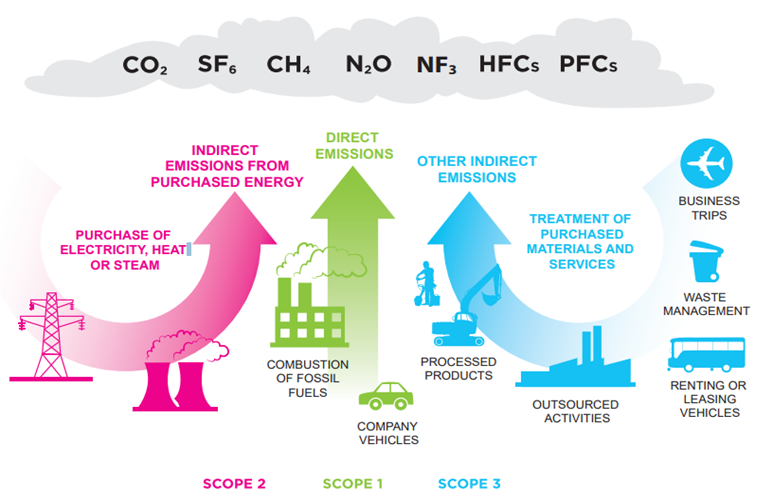What is the difference between Scope 1, 2 and 3 emissions?
If you don’t measure, you can’t manage – and that maxim applies forcefully to a company’s carbon emissions.
But it’s no surprise that measuring greenhouse gas emissions is far from straightforward, which the reason why the Greenhouse Gas Protocol (GHGP) was developed by the World Business Council for Sustainable Development and the World Resources Institute.
The GHGP it has helped define how companies manage and report greenhouse gas emissions (GHG), crucially the establishment of three categories of emissions – Scope 1, Scope 2, Scope 3.
It provides a comprehensive global framework that is standardized to measure and manage emissions from private and public sector operations, value chains, products, cities, and policies.
The GHGP accounting and reporting standards were developed and rigorously tested with participation from businesses, government agencies, NGOs, and academic institutions from around the world.
The three scopes should avoid the “double-counting” of emissions and organizations separate GHG into those that they control and those that they can influence.

Scope 1: direct emissions from owned or controlled sources
This will include all the emissions from the activities of an organisation or under their control, such as fuel burned in owned or controlled boilers, furnaces and vehicles, and emissions from chemical production in owned or controlled process equipment.
Not included are direct CO2 emissions from the combustion of biomass, which is reported separately and any GHG emissions not covered by the Kyoto Protocol, such as CFCs and NOx are not reported under Scope 1 but a company can do so separately
Scope 2: indirect emissions from the generation of purchased energy
This covers indirect emissions from electricity purchased and used by a company. These emissions are created during energy production by the supplier.
Scope 3: all indirect emissions that occur in the value chain
These are all emissions from sources that the company does not own or control, covering areas associated with business travel, procurement, waste and water. They are those not included in scope 2 and extend the reach to account for GHG emissions through the entire value chain of the reporting company, including both upstream and downstream emissions.
Upstream activities or cradle-to-gate emissions include all those that occur in the life cycle of a material/product up to the point of sale by the producer.
Downstream activities are those emissions produced in the life cycle of a product after its sale by the producer, including distribution and storage, product use and end-of-life.
Scope 3 emissions regularly contribute the greatest share of a company’s carbon footprint but the measurement and reporting of them is seen as crucial to the sustained development of effective carbon reduction policies and helps companies identify GHG reduction opportunities, track performance, and engage suppliers at a corporate level.
Scope 3 is known as the Corporate Value Chain Standard and is designed to enable comparisons of a company’s GHG emissions over a period of time but is not designed to support comparisons between companies.
The three scopes help companies to lay a firm foundation for carbon reduction strategies, with the associated financial savings. Within the wider remit, companies can achieve sustainable reductions both within their operations and across global value chains, identifying key areas that generate the biggest GHGs.
Backed by Government
The GHGP is recognised by the UK government as an independent standard for reporting greenhouse gases and while use of the standards is voluntary, it is seen as an essential element in the mandatory Streamlined Energy and Carbon Reporting (SECR) regulations.
The SECR requires annual reporting and disclosure of energy and carbon information within the accounts and came into effect on April 1 2019.
SECR covers all incorporated quoted and “large unquoted companies and limited liability partnerships”. Large companies are de
fined as those that meet two or more of these criteria: Over 250 employees, annual turnover greater than £36 million, annual balance sheet greater than £18 million.
Company annual reports now need to include more detailed reporting on energy usage, energy efficiency and greenhouse gas emissions.
The government is also encouraging all other companies to adopt similar reporting structures.
Positive ROI
Businesses that have embraced the three scopes report a positive ROI along with the improved ability to identify and manage the risks and opportunities around the value chain, as well as engage suppliers and partners in carbon reduction strategies.
One of the sustainability performance indicators most requested by stakeholders is emissions and the three scopes helps to provide more granular and useful data for investors while enhancing corporate reputation through public reporting.
We can help your business achieve compliance cost-effectively. Find out more.
Contact us to discuss how we can help you lower your business carbon footprint across all three scopes.


